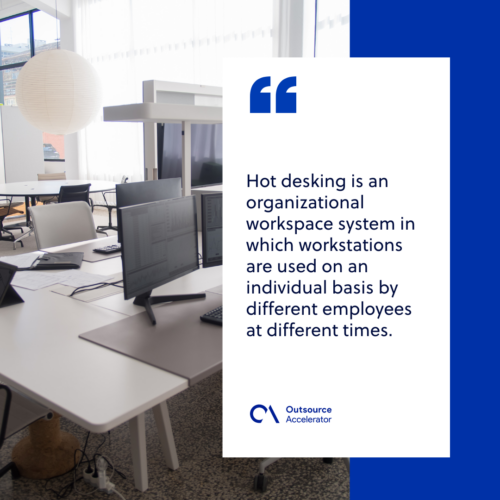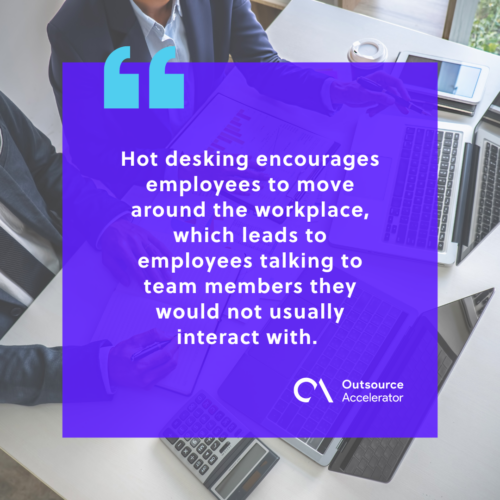Hot desking
Definition
What is hot desking?
Hot desking is an organizational workspace system in which workstations are used on an individual basis by different employees at different times.
By minimizing unnecessary office space, the goal is to enhance space efficiency and reduce real estate risk. Hot desks may be used in private offices and cooperative environments.

Advantages of hot desking
The advantages of hot desking differ for your company will be based on your working style.
While freelancers appreciate having a location to work and interact with possible clients, company owners like the flexible lease agreements, they also take advantage of the flexibility to hire or send employees to workspaces in various cities.
Advantages of hot desking to self-employed workers
If you’re a consultant, freelancer, or entrepreneur who works from the same place, hot desking is a flexible, cost-effective way to locate office space without committing to long-term office agreements.
It helps reduce the isolation that comes with working from home by surrounding you with a network of experts who are working remotely or freelancing for themselves.
Hot desking helps self-employed professionals who are juggling various tasks in different places to locate a workplace and stay connected. This convenience boosts productivity and provides a professional atmosphere in which to meet with clients.

Advantages of hot desking to enterprise companies
Hot desking allows you to acquire remote workers without making a large upfront investment. It allows you to expand your staff where talent exists, without having to permanently set up your place or deal with relocation fees.
Along with scale and expansion, the cost reductions associated with flexible lease arrangements and the outsourcing of office employees, cleaning staff, and the cost of amenities are important incentives for large businesses.
Finally, employee engagement and productivity levels have been shown to rise interestingly in coworking spaces. In line with this, hot desking is an excellent method to leverage this.
Associated with improved cooperation and innovation for all.
Hot desking, whether in a single office or a larger coworking space, brings employees from various teams or organizations together. It gathers together a unique set of professionals.
Through hot desking recommendations, this relationship frequently leads to new prospects. Hot desking also helps in the development of potential clients, investors, partners, or employees.
According to a 2018 study, coworking spaces are useful for connecting entrepreneurs, startups, and inventors. This is accomplished through planned, data-driven workplace design, which incorporates shared spaces and infrastructure, as well as technology like applications or online coworking communities.
When you’re surrounded by a diverse base of experience, it’s natural to come up with fresh ideas and procedures. An ever-changing work environment also reduces the danger of burnout and project exhaustion.
What is the point of hot desking?
Hot desking is intended to save your organization income on workstations, equipment, and office rent. You can also keep your office cleaner, and you may even be able to reduce your company’s carbon footprint, which benefits the environment.
What are the benefits of hot desking?
Here are some benefits of hot desking:
Increase employee collaboration
Hot desking encourages employees to move around the workplace, which leads to employees talking to team members they would not usually interact with. It allows employees from various sections of the organization to work together on projects.
Tidier workspaces
Since employees are unable to leave personal belongings, at the end of the workday, your workplace will likely be cleaner if you adopt hot desking.
Employees who work from home become minimalists. The overall result of acquiring hot desking is a cleaner and more organized workplace.

Employee flexibility and autonomy
Employees gain freedom from hot desking since it allows them to modify their day-to-day environment while remaining flexible.
This offers individuals a lot more freedom and control over how their regular work environment looks and feels. Employees are no longer limited to their workstations.
Lower costs
Traditional offices provide employees a particular place to work in. However, that space goes unused if the employee is out of the office, commuting to or from work, or working from home.
Hot desking reduces wasted space by allowing companies to decrease the use of their area and make better use of current space. Not every employee requires their permanent workstation.
Improve performance and the circulation of knowledge
People tend to work in isolation when they have fixed seating arrangements. However flexible seating arrangements made available by hot desking help to increase performance and encourage the exchange of knowledge.
Hot desking improves communications by promoting more face-to-face interaction and employees may prefer a calm atmosphere where they can concentrate.
This is why it’s crucial to keep a flexible, readily reconfigurable environment available for various jobs, from concentration-heavy solo work to collaborative huddles.
Helps the environment
If your organization wants to be more environmentally conscious and minimize its carbon footprint, hot desking may be the way to go. Instead of 50 or 100 employees pouring into the office each weekday, you just have one or two.
Further, you are not operating several dozen computers at the same time while everyone in your workplace works. Instead, you have no more than five computers running at any given moment. How’s that for helping the environment?







 Independent
Independent




